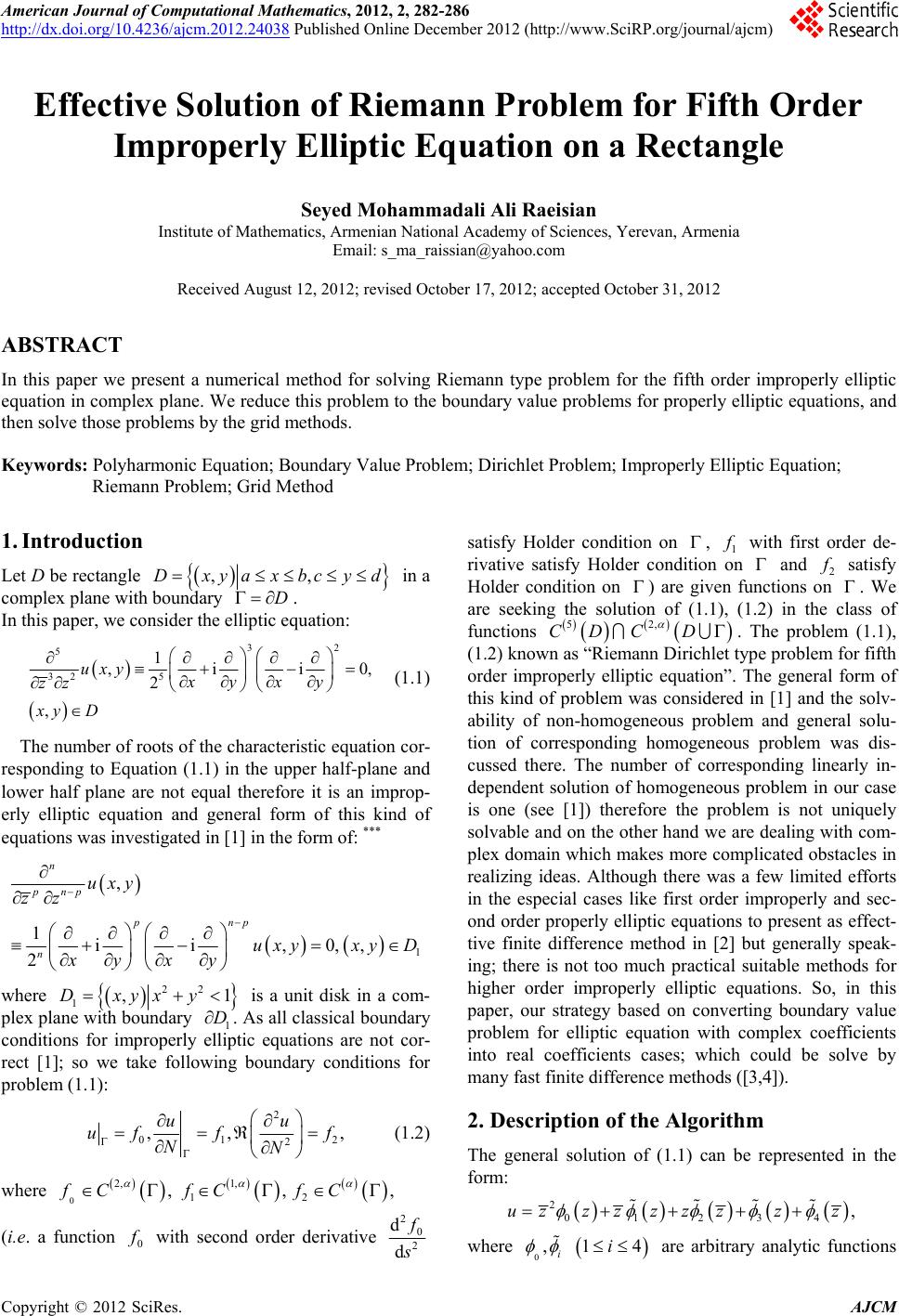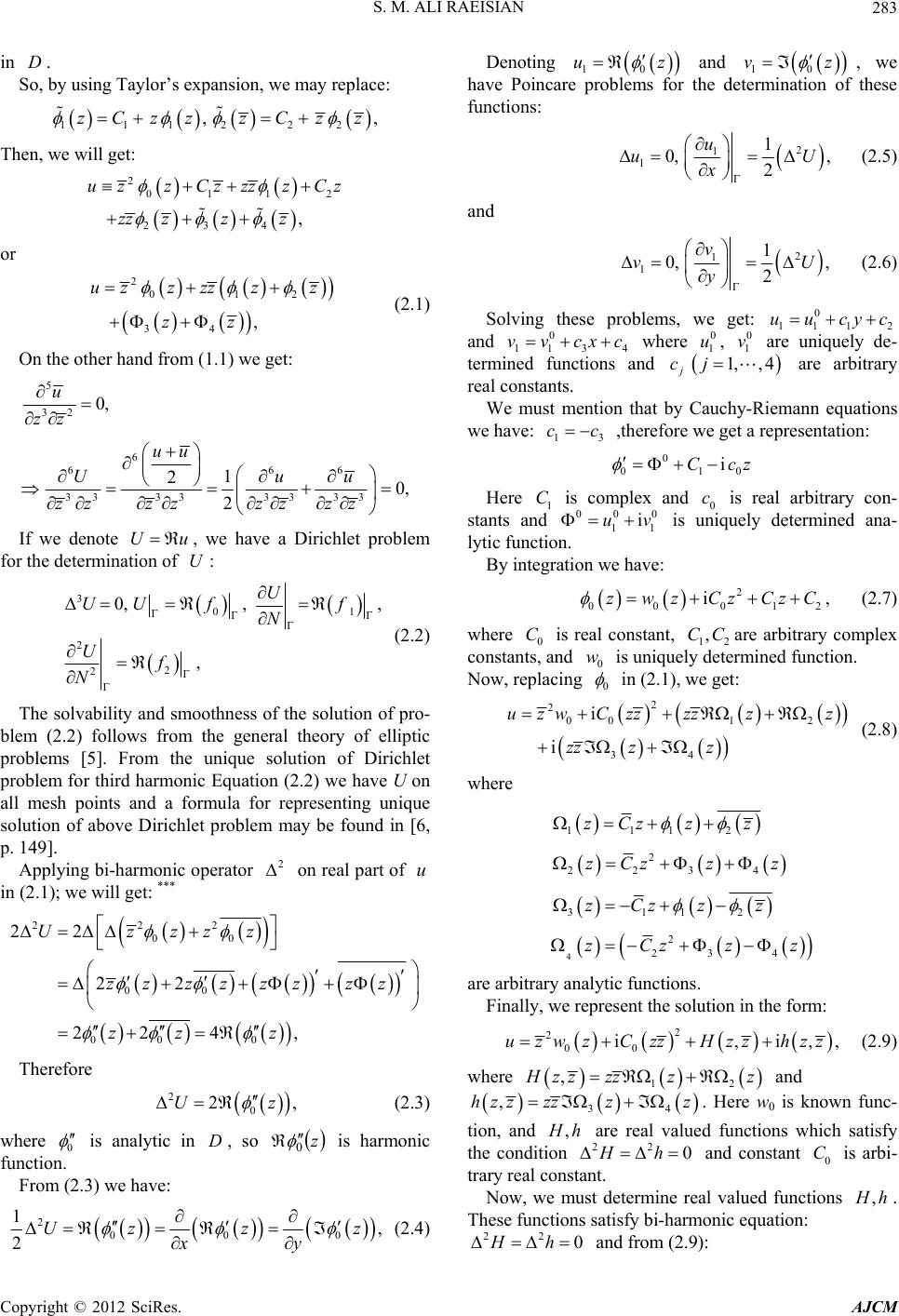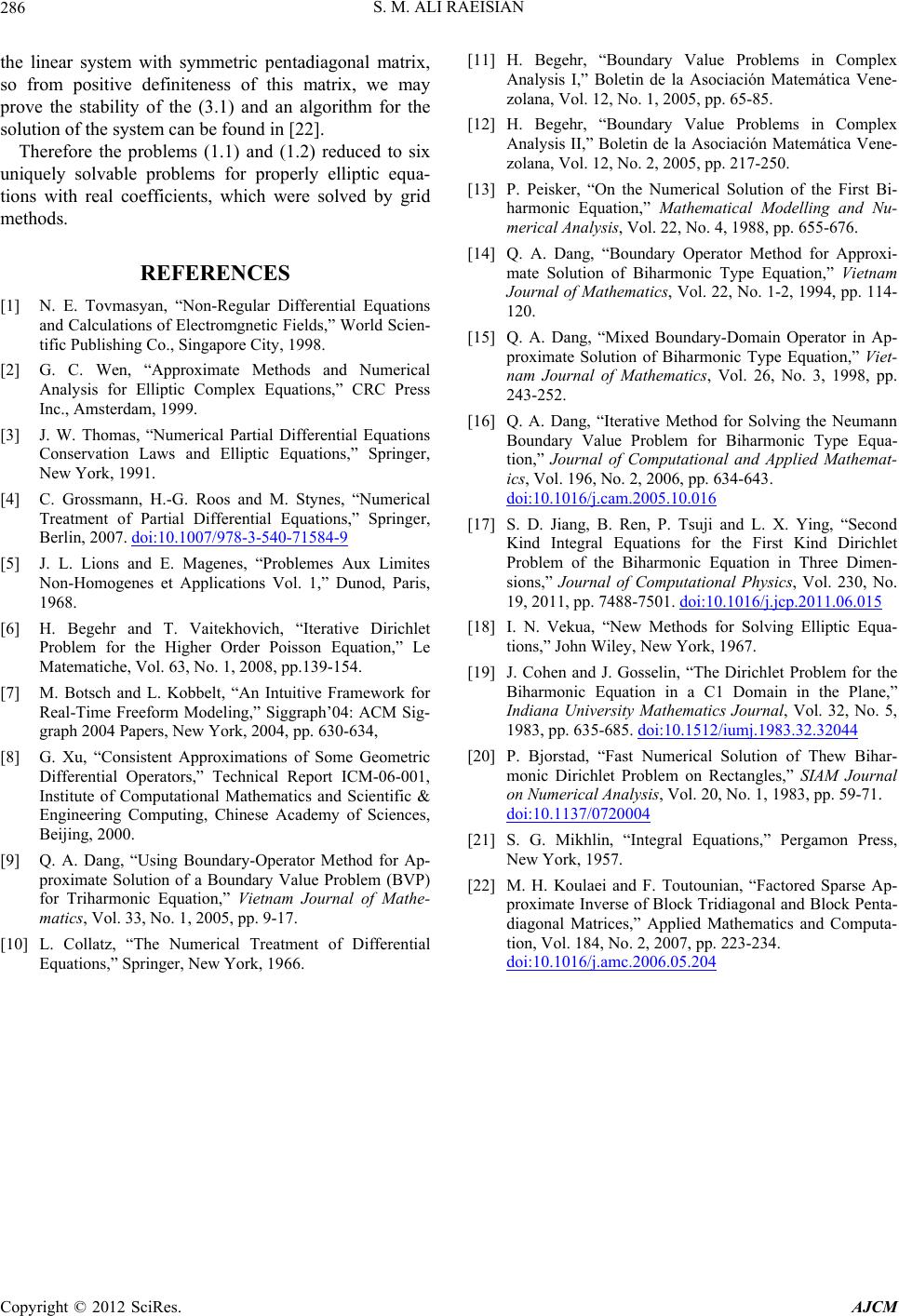 American Journal of Computational Mathematics, 2012, 2, 282-286 http://dx.doi.org/10.4236/ajcm.2012.24038 Published Online December 2012 (http://www.SciRP.org/journal/ajcm) Effective Solution of Riemann Problem for Fifth Order Improperly Elliptic Equation on a Rectangle Seyed Mohammadali Ali Raeisian Institute of Mathematics, Armenian National Academy of Sciences, Yerevan, Armenia Email: s_ma_raissian@yahoo.com Received August 12, 2012; revised October 17, 2012; accepted October 31, 2012 ABSTRACT In this paper we present a numerical method for solving Riemann type problem for the fifth order improperly elliptic equation in complex plane. We reduce this problem to the boundary value problems for properly elliptic equations, and then solve those problems by the grid methods. Keywords: Polyharmonic Equation; Boundary Value Problem; Dirichlet Problem; Improperly Elliptic Equation; Riemann Problem; Grid Method 1. Introduction Let D be rectangle ,,Dxyaxbcyd in a complex plane with boundary D . In this paper, we consider the elliptic equation: 32 5 32 5 1 ,ii 2 , uxy xy xy zz xy D 0, (1.1) The number of roots of the characteristic equation cor- responding to Equation (1.1) in the upper half-plane and lower half plane are not equal therefore it is an improp- erly elliptic equation and general form of this kind of equations was investigated in [1] in the form of: *** 1 , 1ii,0,, 2 n pnp pnp n uxy zz uxyxy D xy xy where 22 1,Dxyxy 1 is a unit disk in a com- plex plane with boundary 1. As all classical boundary conditions for improperly elliptic equations are not cor- rect [1]; so we take following boundary conditions for problem (1.1): D 2 01 2 ,, uu uf ff NN 2 , , (1.2) where 0 2, 1, 12 ,,fCfC fC (i.e. a function 0 with second order derivative 2 0 2 d d satisfy Holder condition on , 1 with first order de- rivative satisfy Holder condition on and 2 satisfy Holder condition on ff ) are given functions on . We are seeking the solution of (1.1), (1.2) in the class of functions . The problem (1.1), (1.2) known as “Riemann Dirichlet type problem for fifth order improperly elliptic equation”. The general form of this kind of problem was considered in [1] and the solv- ability of non-homogeneous problem and general solu- tion of corresponding homogeneous problem was dis- cussed there. The number of corresponding linearly in- dependent solution of homogeneous problem in our case is one (see [1]) therefore the problem is not uniquely solvable and on the other hand we are dealing with com- plex domain which makes more complicated obstacles in realizing ideas. Although there was a few limited efforts in the especial cases like first order improperly and sec- ond order properly elliptic equations to present as effect- tive finite difference method in [2] but generally speak- ing; there is not too much practical suitable methods for higher order improperly elliptic equations. So, in this paper, our strategy based on converting boundary value problem for elliptic equation with complex coefficients into real coefficients cases; which could be solve by many fast finite difference methods ([3,4]). CD , D 52 C 2. Description of the Algorithm The general solution of (1.1) can be represented in the form: 2 01234 ,uzzz zzzzz where 0,1 4 ii are arbitrary analytic functions C opyright © 2012 SciRes. AJCM  S. M. ALI RAEISIAN 283 in . D So, by using Taylor’s expansion, we may replace: 1112 22 ,zCzzzCzz , Then, we will get: 2 011 234 , uzz Czzzz Cz zz zzz 2 or 2 012 34 , uzz zzzz zz (2.1) On the other hand from (1.1) we get: 5 32 0, u zz 6 66 3 3333333 1 20, 2 uu Uu z zzzzzzz 6 u u If we denote , we have a Dirichlet problem for the determination of : U U 3 01 2 2 2 0, ,, , U UU ff N Uf N (2.2) The solvability and smoothness of the solution of pro- blem (2.2) follows from the general theory of elliptic problems [5]. From the unique solution of Dirichlet problem for third harmonic Equation (2.2) we have U on all mesh points and a formula for representing unique solution of above Dirichlet problem may be found in [6, p. 149]. Applying bi-harmonic operator on real part of in (2.1); we will get: *** 2 u 222 00 00 00 0 22 22 22 4, Uzzzz z zzzzzzz zz z Therefore 2 0 2U ,z (2.3) where 0 is analytic in , so is harmonic function. D z 0 From (2.3) we have: 00 0 1, 2Uzz z xy 2 (2.4) Denoting 10 uz and 10 v z, we have Poincare problems for the determination of these functions: 2 1 1 1 0, , 2 u uU x (2.5) and 2 1 1 1 0, , 2 v vU y (2.6) Solving these problems, we get: 2 and 4 0 111 uucyc 0 11 3 vvcxc where , are uniquely de- termined functions and are arbitrary real constants. 0 1 u cj 0 1 v 1, , 4 j We must mention that by Cauchy-Riemann equations we have: 1 cc 3 ,therefore we get a representation: 0 01 iCcz 0 0 1 Here 1 is complex and 0 c is real arbitrary con- stants and is uniquely determined ana- lytic function. C 00 1 iuv By integration we have: 2 00 01 i,zwzCzCzC 2 (2.7) where 0 is real constant, 12 are arbitrary complex constants, and is uniquely determined function. C,CC 0 w Now, replacing 0 in (2.1), we get: 2 2 001 2 34 i i uzwCzzzzzz zz zz (2.8) where 1112 zCz zz 2 2234 zCz z z 3112 zCz zz 4 2 23 4 zCzzz are arbitrary analytic functions. Finally, we represent the solution in the form: 2 2 00 i,iuzwz CzzHzzhzz ,, (2.9) where 12 , zz zzzz and 34 ,hzz zzzz. Here w0 is known func- tion, and , h are real valued functions which satisfy the condition 22 0Hh and constant is arbi- trary real constant. 0 C Now, we must determine real valued functions , h. These functions satisfy bi-harmonic equation: 22 0Hh and from (2.9): Copyright © 2012 SciRes. AJCM  S. M. ALI RAEISIAN 284 2 0,,UzwzHxy Hence, we have following Dirichlet conditions on the boundary : 2 00 2 10 , , Hfzwz Hfzwz NN Finally we get the “Dirichlet problem for bi-harmonic equation”: 2 2 00 2 10 0, , , H Hfzwz Hfzwz NN (2.10) which has a unique solution. Analogously, we get the same boundary problem: 2 2 00 ,,uzwzCzzhxy i.e.: 2 2 00 ,hxyuzw zCzz , (2.11) for determination of function h. This problem includes arbitrary constant , therefore must be modified. 0 So, first we find the function 0, by solving “Dirichlet problem for bi-harmonic equation”: Ch 2 0 2 0 2 0 0, , , h hzz hzz NN (2.12) and then ,we solve: 2 1 2 10 2 00 2 1 0 2 10 0, , , h hu zwz fzwz huzw NN N fzwz N z (2.13) These problems are uniquely solvable, and the solution of (2.11) will be . 100 Replacing the function h into (2.9), we find: hh Ch 2 0 2 100 0 , i, ,i uzwzHxy hxy ChxyCzz , or: 2 2 010 ,i,iuzwz HxyhxyC zzh 0 , So, during above argument we had proved that by us- ing our algorithm; we can find the solution of the prob- lems (1.1) and (1.2) with only one constant 0, and line- arly independent solution for corresponding homogene- ous problem is C 2 00 i,uzzh Here 0 is bi-harmonic function and uniquely deter- mined from problem (2.12). h 3. Numerical Solution Let us divide the rectangle D by N − 1 straight lines, par- allel to coordinate axes and for simplicity the nodes are equidistant which denoted by: ,,0, ,,0, k j ba ,. ,. akhhk N N dc ycjhhj N N Let’s consider Dirichlet problem for tri-harmonic Equation (2.2). The tri-harmonic equation is a sixth order elliptic partial differential equation: 6666 3 64224 3, UUU U6 U xy xyy which is encountered in viscous flow problems. In the general case, poly-harmonic equation kUf , in the discrete setting, are usually solved by applying a Laplacian discretization repeatedly on a mesh, with the cotangent formula being the most popular and the one used in [7]. Although this formulation is efficient and particularly useful in interactive applications, it sup- ports only one particular way of specifying boundary conditions and the results often have significant mesh dependence. The convergent discretization based on a quadratic fitting scheme could be found in [8]. Anyway, Dang Q. A. [9] studied an iterative method for solving a BVP for a tri-harmonic type equation based on using boundary domain operator defined on pairs of boundary and domain functions in combination with parametric extrapolation technique and reduces the BVP for sixth order equation to a sequence of BVPs for Poisson equa- tion. Next, For finding numerical solution of Poincare prob- lems (2.5) and (2.6); we solve it in domain with the boundary , whereas ,:, , ,1, ij i j xyxa hbh ychdh ijN 1, where the values of are known on the boundary 2 hh U Copyright © 2012 SciRes. AJCM  S. M. ALI RAEISIAN 285 points . Because of simplicity and getting rid of com- plexity of the system , we may assume two points in (2.5) on the top left and down right corner of the bound- ary are fixed, i.e.: 00 ,, yahdh , and ,, 11 yb hc h 10111 11 ,0,,uuxy u 1 u 11 ,,, 0,,kjkj so: 100 uxy 0, N By denote the values of function in the mesh points approximately: j k uu and from the grid boundary conditions: 2 11 1,,1,,1 4 jj j iihh i uu UijN h 1 we will find the values in the grid points on the sides of parallel to OX axis. Finally, the values of 1 i u inside and on the sides parallel to OY axis will be found from the sys- tem of linear equation, main matrix of this system may be reduced to the tri-diagonal form : 0... ...0 0...0 0.. 0000... AB BAB BAB T.0 , where: 222 22 22 11 00 141 0 14 00 , 41 11 000 000...00 0 10 ... 0 0 001...00 , ... ... ...... ... 000 ... 10 000...00 hh hh h hh A hh hh B the matrix T is diagonally dominant, therefore this linear system is uniquely solvable; so considered modified Poincare problem is uniquely solvable too and then from maximum principle [10], we have unique solvability of this system. Next, we consider the problem (2.10). A fast solver for compact discretizations of the bi-harmonic problem was presented in [11-13], also Dang Q. A. in [14,15] with the help of boundary or mixed boundary-domain operators introduced appropriately, constructed iterative methods for bi-harmonic and bi-harmonic type equations associ- ated with the Dirichlet, Neumann or simple type of mixed boundary conditions. By finite difference method, we find the values of the function in the mesh points approximately: ,,1, ,,1, ,. j i Hijim jn we use the discrete analogue of the Laplace operator: 21 11 2 14, jjjjj hhiiiii HHHHHH h 1 and may discretisize biharmonic equation in (2.10) as 11 4 11 4 1111 1111 4 22 22 4 01 20 8 4 8 2 1, ,. jjj hh hiii jj ii jjjj iiii jjj j iii i hh h h HHHH h h HH h HHHH h HHH H h Hf Hf (3) Here forward divided differences for the operator N in (2.10) noted by h ,and h h 01 , fre values of functions a , 01 f n ob the boundary points of mesh. The in ditainn [16], tends to (3.1) approximates the problem (2 scretizatioed here and also i symmetric matrices so the convergence analysis is simpler, but there now exist standard fast numerical al- gorithms for this kind of boundary value problems too. In [17-19] for the two dimensional case, problem (2.10) has been reduced to second kind integral equations and a fast numerical algorithm is developed based on the con- structed SKIE in [20]. The discrete problem .10) (see [21]), therefore, from the stability of the problem (3.1), we have the convergence of the grid func- tion to , ij xy [3, p. 30, Theorem 2.5]. From the last ation of the two equ(3.1); we find the values of the func- tion h in the points ,,0,1,, ij yij N and if aluthe ves i are on im from nterior nodes, we find the Copyright © 2012 SciRes. AJCM  S. M. ALI RAEISIAN Copyright © 2012 SciRes. AJCM 286 duced to six un REFERENCES [1] N. E. Tovmasferential Equations d Numerical al Partial Differential Equa -G. Roos and M. Stynes, “Numerical the linear system with symmetric pentadiagonal matrix, so from positive definiteness of this matrix, we may prove the stability of the (3.1) and an algorithm for the solution of the system can be found in [22]. Therefore the problems (1.1) and (1.2) re iquely solvable problems for properly elliptic equa- tions with real coefficients, which were solved by grid methods. yan, “Non-Regular Dif and Calculations of Electromgnetic Fields,” World Scien- tific Publishing Co., Singapore City, 1998. [2] G. C. Wen, “Approximate Methods an Analysis for Elliptic Complex Equations,” CRC Press Inc., Amsterdam, 1999. [3] J. W. Thomas, “Numerictions Conservation Laws and Elliptic Equations,” Springer, New York, 1991. [4] C. Grossmann, H. Treatment of Partial Differential Equations,” Springer, Berlin, 2007. doi:10.1007/978-3-540-71584-9 [5] J. L. Lions and E. Magenes, “Problemes Aux Limites gehr and T. Vaitekhovich, “Iterative Dirichlet work for sing Boundary-Operator Method for Ap- nt of Differential Non-Homogenes et Applications Vol. 1,” Dunod, Paris, 1968. [6] H. Be Problem for the Higher Order Poisson Equation,” Le Matematiche, Vol. 63, No. 1, 2008, pp.139-154. [7] M. Botsch and L. Kobbelt, “An Intuitive Frame Real-Time Freeform Modeling,” Siggraph’04: ACM Sig- graph 2004 Papers, New York, 2004, pp. 630-634, [8] G. Xu, “Consistent Approximations of Some Geometric Differential Operators,” Technical Report ICM-06-001, Institute of Computational Mathematics and Scientific & Engineering Computing, Chinese Academy of Sciences, Beijing, 2000. [9] Q. A. Dang, “U proximate Solution of a Boundary Value Problem (BVP) for Triharmonic Equation,” Vietnam Journal of Mathe- matics, Vol. 33, No. 1, 2005, pp. 9-17. [10] L. Collatz, “The Numerical Treatme Equations,” Springer, New York, 1966. [11] H. Begehr, “Boundary Value Problems in Complex Analysis I,” Boletin de la Asociación Matemática Vene- zolana, Vol. 12, No. 1, 2005, pp. 65-85. [12] H. Begehr, “Boundary Value Problems in Complex Analysis II,” Boletin de la Asociación Matemática Vene- zolana, Vol. 12, No. 2, 2005, pp. 217-250. [13] P. Peisker, “On the Numerical Solution of the First Bi- harmonic Equation,” Mathematical Modelling and Nu- merical Analysis, Vol. 22, No. 4, 1988, pp. 655-676. [14] Q. A. Dang, “Boundary Operator Method for Approxi- mate Solution of Biharmonic Type Equation,” Vietnam Journal of Mathematics, Vol. 22, No. 1-2, 1994, pp. 114- 120. [15] Q. A. Dang, “Mixed Boundary-Domain Operator in Ap- proximate Solution of Biharmonic Type Equation,” Viet- nam Journal of Mathematics, Vol. 26, No. 3, 1998, pp. 243-252. [16] Q. A. Dang, “Iterative Method for Solving the Neumann Boundary Value Problem for Biharmonic Type Equa- tion,” Journal of Computational and Applied Mathemat- ics, Vol. 196, No. 2, 2006, pp. 634-643. doi:10.1016/j.cam.2005.10.016 [17] S. D. Jiang, B. Ren, P. Tsuji and L. X. Ying, “Second Kind Integral Equations for the First Kind Dirichlet Problem of the Biharmonic Equation in Three Dimen- sions,” Journal of Computational Physics, Vol. 230, No. 19, 2011, pp. 7488-7501. doi:10.1016/j.jcp.2011.06.015 [18] I. N. Vekua, “New Methods for Solving Elliptic Equa- tions,” John Wiley, New York, 1967. [19] J. Cohen and J. Gosselin, “The Dirichlet Problem for the Biharmonic Equation in a C1 Domain in the Plane,” Indiana University Mathematics Journal, Vol. 32, No. 5, 1983, pp. 635-685. doi:10.1512/iumj.1983.32.32044 [20] P. Bjorstad, “Fast Numerical Solution of Thew Bihar- monic Dirichlet Problem on Rectangles,” SIAM Journal on Numerical Analysis, Vol. 20, No. 1, 1983, pp. 59-71. doi:10.1137/0720004 [21] S. G. Mikhlin, “Integral Equations,” Pergamon Press, New York, 1957. [22] M. H. Koulaei and F. Toutounian, “Factored Sparse Ap- proximate Inverse of Block Tridiagonal and Block Penta- diagonal Matrices,” Applied Mathematics and Computa- tion, Vol. 184, No. 2, 2007, pp. 223-234. doi:10.1016/j.amc.2006.05.204
|